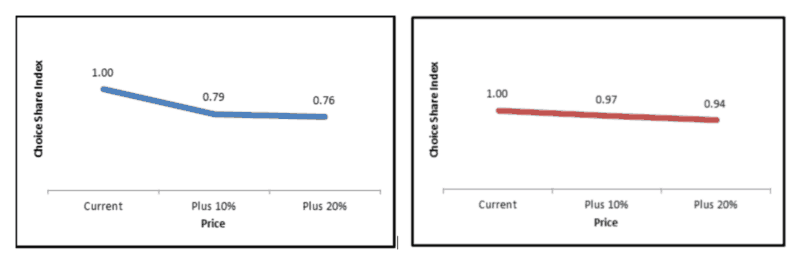There are two key benefits of conducting pricing research: (i) the prediction of consumers’ response to price changes, and (ii) the discovery of psychological effects of price points on sales (demand). Indeed, Pricing strategies based on accurate predictions of potential outcomes give organizations a strong advantage to improve revenues.
When used correctly, pricing research is able to predict customer perception of the new price, and as the result, what impact a price increase may have on revenue. Whether you are planning to increase prices or thinking to price a new product, research is the key to effective pricing strategy.
Understanding the Effects of Changing Prices
Determining the effect of changed prices on sales volume is one of the most difficult challenges in the management sector. While it is expected that initially, sales will drop after a price increase, the crucial question is: by how much? Would the drop in sales equal the increase in prices, percentage wise? Would sales drop at a rate greater or less than that of the price increase? Graphs 1a, 1b and 1c show 3 potential outcomes.
To avoid unexpected revenue drop after implementing a price increase, it is crucial to conduct price-point testing and pricing research prior to the changes. For cost-plus pricing businesses, understanding the psychological effects of pricing (price points, price structures, price formats, price framing and price communication) not only can help to set optimal price points, but also identify new profit opportunities. Consumers perceive additional messaging/information from price-points and react atypically to certain types of prices.
The Left-Digit Effect
In the presence of psychological pricing, consumers will react more drastically at key price points. This results in a ‘kinked’ demand curve (sales) with inflection points. As Paul Hunt & Jim Saunders explain in World Class Pricing: The Journey, “once you price over a ‘pricing threshold’, demand may drop precipitously”. One reasoning for this being consumers perceive these price points as being significantly lower than they actually are. Consumers usually process prices by focusing on the far left digit and separating prices into parts instead of processing them as an entity. For example; $0.99 would seem a lot cheaper than $1.00 even though it is only 1 cent less. The number of digits on the price tag does not affect this tendency, as even luxury property in Beverly Hills sells better “for $7,995,000 rather than $8 million“.
Choice Based Models
To evaluate new price impact on sales, one must be able to predict how customers will react. Pricing Solutions often applies the choice-based model, which is among the most suitable marketing research tools for pricing. The model suggests the following evaluation criteria for prediction:
- Buying Occasion: The buying occasion accurately mimics the marketplace.
- Blind: The respondent is not aware of which product is the key focus of the study.
- Indirect: The respondent is not aware that the study is focused on pricing.
The model is calibrated based on a series of purchasing scenarios made by respondents. The choice share at different price points provides insights regarding the existence of price thresholds. Essentially, 2 hypotheses can be tested in the same study with 2 different model specifications:

Graph 2 shows how new price points impact sales.
In one example, a leading toy manufacturer wanted to predict consumers’ reactions to a price increase of 10% across their product portfolio. The research indicated that Product A was a price threshold (Blue Graph). The potential decrease in demand for moving the price over this threshold was larger relative to the loss in demand at other price changes. The demand curve of Product Red as opposed to Product Blue, was a smooth line with no “kinks” or inflection points, meaning a price increase – even of 20 – does not have a significant negative impact on demand. Ultimately, marketing research provides ample opportunities for gaining insights into consumers’ responses to price changes. The payoffs include better pricing strategies that contribute to sustainable revenue increases.
Developing a Strong Pricing Strategy
Pricing Research can go a long way in helping you discover and create new opportunities for your business. Pricing Solutions is an industry leader in this field and can help your company conduct effective pricing. We’ve written about how increasing your prices can be a hard step for businesses to take, however, it is pivotal for the health of any company. So whether your objectives are to reevaluate your current pricing structures or to raise prices, it is important to capitalize on the psychological pricing and set optimal price points. Any change in your prices might see a decrease in volume, so it is important that you reanalyze your pricing method. By doing so you can accurately see the effects of the price change and ensure that you are not leaving any profits behind.






